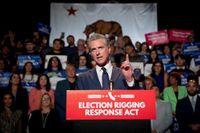California Governor Gavin Newsom has ignited a fierce political battle with former President Donald Trump’s administration, unveiling a plan to redraw the state’s congressional map in a move designed to counter Republican gerrymandering efforts in Texas and other red states. The announcement, made on August 14, 2025, at the Japanese American National Museum in Los Angeles, marked the latest escalation in a nationwide fight over the future of American democracy and congressional representation.
Newsom’s bold proposal calls for an off-cycle redistricting of California’s congressional map, a step that would require approval through a special statewide election set for November 4, 2025. According to Rolling Stone, Newsom framed the move as a direct response to Texas Governor Greg Abbott’s call for a new special session to push through a gerrymandered map favoring Republicans. Newsom declared, “We have got to recognize the cards that have been dealt, and we have got to meet fire with fire.” He added, “Trump doesn’t play by a different set of rules. He doesn’t believe in the rules.”
The governor’s announcement was anything but routine. As Newsom spoke, masked federal Border Patrol agents arrived outside the venue, conducting arrests and drawing sharp criticism from state and local officials. Newsom condemned the federal presence as a “sick and pathetic” stunt, telling the audience, “This is a serious moment. Who else sends ICE at the same time while having a conversation like this? Someone who is weak, broken. His weakness is masquerading as a strength.” Los Angeles Mayor Karen Bass echoed the sentiment, describing the raid as an intentionally “provocative act.”
The symbolism of the venue was not lost on observers. The Japanese American National Museum stands on the site where Japanese Americans were gathered before being sent to internment camps during World War II. The presence of federal agents at this location, as reported by the Los Angeles Times, evoked memories of past injustices and heightened the tension surrounding the event. One man delivering strawberries was arrested outside, while inside, elected officials and supporters erupted in chants of “Sí, se puede.”
Newsom’s campaign against Trump and Republican gerrymandering has not been confined to legislative proposals. Over the past week, his press office has taken to social media, mimicking Trump’s signature all-caps style and bombastic tone. According to Axios, the posts have included lines like, “DONALD IS FINISHED — HE IS NO LONGER ‘HOT,’” and “LIBERATION DAY FOR AMERICA,” referencing California’s proposed new congressional maps. The tweets, signed “GCN” as a riff on Trump’s “DJT,” have lampooned everything from Trump’s polling numbers to his use of “the little baby stairs” on Air Force One.
Newsom explained his strategy to reporters, saying, “I’m just following his example. If you have issues with what I’m putting out, you sure as hell should have concerns with what he’s putting out as president.” He questioned why Trump’s social media posts had become normalized over the years, asking, “How have we allowed the normalization of his tweets, Truth Social posts over the course of the last many years, to go without similar scrutiny and notice?”
The trolling campaign has not gone unnoticed by the White House. Deputy Press Secretary Abigail Jackson dismissed the tweets as “very weird and not at all funny,” while White House Director of Communications Steven Cheung called Newsom a “coward and Beta Cuck.” Newsom’s press office fired back in Trumpian style: “Steven Cheung (incompetent Trump staffer) doesn’t know how to use his computer. SAD!”
The stakes of this political showdown are high. Texas Republicans, led by Governor Abbott, are determined to push through a new congressional map that could tip the balance of power in the 2026 midterms. California’s proposed response, as outlined by Newsom, would be triggered only if the Legislature approves the Election Rigging Response Act by a two-thirds vote. If passed, the new districts would exist temporarily and be redrawn after the 2030 Census by California’s independent Citizens Redistricting Commission. The move is designed to send a clear message: if Republicans in Texas and other states proceed with partisan redistricting, California will not stand idly by.
Newsom linked the current fight to broader concerns about the health of American democracy. He accused Trump and the GOP of trying to “rig an election” by denying Democratic voters an effective franchise through gerrymandering. “Here he is once again trying to rig an election,” Newsom said, referencing Trump’s infamous phone call seeking to “find me five seats” and drawing parallels to the events of January 6, 2021. “We cannot watch this democracy disappear district by district, not just in Texas, but in Missouri, Indiana, Ohio, and Florida.”
California’s approach differs from Texas in one key respect: transparency. Newsom emphasized that the proposed map would be put on the ballot, giving power to the people to approve or reject it. If the measure passes, the new districts would temporarily replace the current map, but would be subject to further revision after the next Census. Should Texas or other states abandon their gerrymandering efforts, California’s map would remain unchanged.
Congressmember Salud Carbajal of Santa Barbara weighed in, telling the Santa Barbara Independent, “Trump and the Republicans know their policies, such as the tariff-taxes, Big Beautiful Bill, and immigration raids, are unpopular so they are trying to steal enough congressional seats to stay in power. I fully support Governor Newsom’s efforts to protect our democracy, and the will of the American people, from this unprecedented power grab.”
The logistics of the proposed special election are already under consideration. Joe Holland, Santa Barbara County’s registrar of voters, revealed that his office had prepared a cost estimate of $2.225 million for the election, with hopes that county taxpayers would not be left to foot the bill. The Election Rigging Response Act contains provisions for state reimbursement of local election costs.
Should the special election move forward and the new map be approved, it could have significant implications for California’s midterm primary in June 2026 and the general election in November 2026. Newsom, for his part, remains defiant, predicting that Trump’s presidency will end in 17 months and urging voters to “stand up to Donald Trump on November 4, in response to bullying and intimidation, and to save democracy across the United States.”
With both sides digging in, the battle over redistricting is shaping up to be a defining conflict in the lead-up to the 2026 midterms. As Newsom put it, “Wake up, America. This is a serious moment.” The next few months will reveal whether California’s gamble pays off—or whether the nation’s political map is redrawn in ways that will reverberate for years to come.


